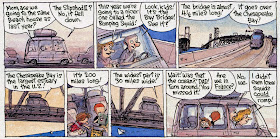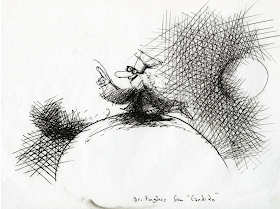Chiaroscuro, (/kiˌɑːrəˈskjʊəroʊ/) the art term so unspellable that I'm forced to copy & paste it, means light-dark in Italian, and strong contrasts between the two in English. And like most Italian words, it's fun to say and makes you vaguely hungry.
Chiaroscuro is one of the four canonical painting modes of the Italian Renaissance, the others being Unione, Cangiante and Sfumato, something I just learned on Wikipedia. Of the four, I'd heard of Sfumato, of which the most famous example is Leonardo's celebrated Mona Lisa, and if anyone were to market a quiescently frozen dessert called "Sfumato," I'd eat my weight in it. Chiaroscuro is also one of my favorite ways of working because it makes a caricature look like more than it is.
Consider this unfinished caricature of Mark Twain, which I intended as a Christmas present for my dad (long story). I was pretty obviously mimicking myself (see below). The paper color is called Tobacco, and it was one of my favorites. Unfortunately, Canson changed the color of the paper, shifting it slightly toward red and spoiling it for my purposes. Every time I tried to use it, the drawing looked too "hot," the shadows and half-tones would be too warm, etc... I needed a more neutral color.
As I said, I was copying myself, using what'd worked before. Start with the highlights, then work darker, using the middle tones (in this case, the paper) as a fixed point.
This worked well, until I used actual paint. As long as I faked it with colored pencils and mixed media, I was alright. But I had pretensions that colored pencils couldn't satisfy, and a good subject to try them out on. A friend, Dave Bragunier, then the tubist and personnel manager of the National Symphony Orchestra, made the mistake of asking for a caricature of then-conductor of the NSO, Mstislav Rostropovich (I copy and pasted that too) in the style of the Beethoven. Unfortunately, we don't have room on this blog to explore this digression fully, but suffice it to say I took years of dawdling to not finish the painting. This was as far as I got-
To find out the exciting conclusion of this unnecessary and irrelevant anecdote, pre-order Th Art of Procrastinatin' Sam, or whatever the hell it's called. (Which is now #1,000,000+ on Amazon's list. C'mon people, get with it!)
By now I was completely in love with technique, usually at the expense of the art. My dad, a former photographer, after I'd shown off my latest pile of highly specialized brushes, said that there were photographers who fell a little too in love with the glamor of the equipment. I knew what he meant; I'd reread art catalogs and painters' guidebooks until they hung in tatters. The more obscure the better, and the most specialized was the Kremer Pigment catalog. Little bottles full of pure, powdered color, odd art supplies from 100-year-old shops have a great, alchemy-lab charisma.
Look at the above illustration, or rather the lower left portion thereof. That's an attempt at an underpainting in egg tempera. Egg tempera is one of the oldest blah blah blah, its permanence is tra la la, and it is excellent for underpainting an oil painting (well, an egg tempera-oil painting or mischtechnik. Y'see, there are all these paint layers that interlock as they dry...oh, Google it). There are thousands of recipes for tempera-oil painting and I had them all, the more obscure and poisonous the better (ask me about megilp). That green I used in the lower left is Verona green earth, historically ideal for shadowed flesh tones. Sounds good to me! So I had a store-bought tube of paint, and I also had a little bottle of pigment sitting on my shelf, ready to be left sitting on my shelf, unused, along with about a hundred other such jars filled with the most arcane stuff imaginable, also unused, but utility wasn't the point; having rows of little jars was.

The point was authenticity; no, not authenticity, it was needless complication. For the support I'd glue together (using rabbitskin glue!) two pieces of Masonite (it had better be unoiled!). Then, in an elaborate process, the surface was prepared. I got quite good at this. In fact, I've got a box of boards somewhere. I had trouble with the part where you put the paint on it to make a picture, was all.
To prepare a board for mischtechnik (or egg tempera), you use gesso, which is NOT the acrylic gesso sold in buckets (feh!) but a white fluid paint made of gypsum slaked in water (I once slaked my own gypsum!) and animal glue. This is painted on the board warm, in layers of opposite direction and allowed to dry. Then you sand it smooth with several grades of sandpaper, ending with fine steel wool. The end product is a white surface that's utterly smooth & level.
I hadn't meant to get bogged down lecturing on technique. Those who've seen the documentary by Teller Tim's Vermeer know where unchecked obsessions lead; among other places a documentary by Teller. So I'm going to show some pictures-
Ollie North (remember how he rampaged around the country?) in tube egg tempera and oil. A bit stiff, I'm trying stuff I don't know how to do.
Phil Gramm, for Mother Jones. Kinda cool, with the hand. I like the sky.
Hector Berlioz. I worked on this forever. I had intricate plans for doing this one; elaborate sketches, detailed notes, etc.. I even had a bottle of copper resinate for his green jacket. But planning a masterpiece and being inspired are two very different things. The copper resinate smelled so vile I wiped it off and threw the bottle away. It may have been this piece that made me realize that I wasn't meant for plans and plots and inductions dangerous. It goes against my nature,, which doesn't admit to non-spontenaity. Replaced by this, a better work.







































